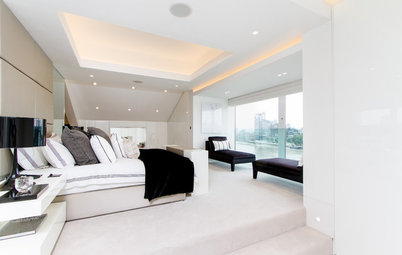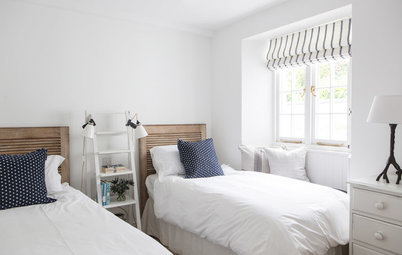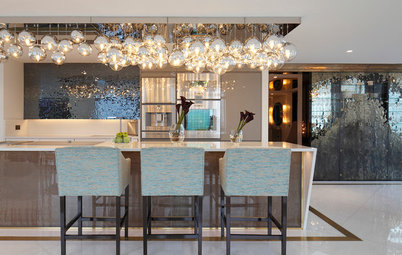Decorating
Illuminating Ideas for Planning Perfect Lighting
As the nights draw in and we rely more on artificial light, let’s go back to basics and mug up on how to create the perfect lighting scheme
Lighting is often overlooked when designing a home, yet it’s vital not only to its functionality, but to its atmosphere and even its safety. All too often, a scheme that is sensational in sunlight under-delivers at night, when poor, flat lighting leaves the space feeling unappealing, and attractive details are lost in the gloom. So as autumn looms and natural light become scarce, let’s go back to school and learn about lighting. From knowing your ambient from your accent light to finding the right fixtures, read on for instant illumination.
Consider who uses the space
Next, work out who uses the room. A 60-year-old uses 15 times more light for reading than a child of 10. Think about when these people will be in the room, too, and what natural light it gets and from which direction.
Next, work out who uses the room. A 60-year-old uses 15 times more light for reading than a child of 10. Think about when these people will be in the room, too, and what natural light it gets and from which direction.
Know your lighting types
A successful lighting scheme relies on four types of light: natural, background or ambient, accent and task. A good balance of each will give your home the best results, with lighting that is both practical and pleasing. Read on to discover how to incorporate all four sources.
A successful lighting scheme relies on four types of light: natural, background or ambient, accent and task. A good balance of each will give your home the best results, with lighting that is both practical and pleasing. Read on to discover how to incorporate all four sources.
Add accent lighting
This is any lighting that brings texture, focus and shape to the ambient, background light. You can use it to highlight a favourite painting or group of objects on a shelf, or simply to create a wash of light across a wall to make a room feel warmer and more intimate.
Discover more bathroom lighting options.
This is any lighting that brings texture, focus and shape to the ambient, background light. You can use it to highlight a favourite painting or group of objects on a shelf, or simply to create a wash of light across a wall to make a room feel warmer and more intimate.
Discover more bathroom lighting options.
Maximise natural light
If your home is not blessed with a wonderful wall of glazing like this one, there are still many things you can do to make the most of natural light. Keep window dressings to a minimum or fit filmy voiles. Install a fanlight above the front door and replace the solid panelling on inner doors with glass. Use light reflective surfaces, such as pale floorboards, and hang mirrors, particularly opposite windows.
If your home is not blessed with a wonderful wall of glazing like this one, there are still many things you can do to make the most of natural light. Keep window dressings to a minimum or fit filmy voiles. Install a fanlight above the front door and replace the solid panelling on inner doors with glass. Use light reflective surfaces, such as pale floorboards, and hang mirrors, particularly opposite windows.
Top up with task lighting
As its name suggests, task lighting is any light that supports a particular activity, from chopping veg to writing or sewing. A fully adjustable Anglepoise-style lamp that can be angled and lowered is a classic example of task lighting, but you might also use clip-on lights, which can be moved around, and pull-down pendants.
Find more ways to work an angled lamp into each room
As its name suggests, task lighting is any light that supports a particular activity, from chopping veg to writing or sewing. A fully adjustable Anglepoise-style lamp that can be angled and lowered is a classic example of task lighting, but you might also use clip-on lights, which can be moved around, and pull-down pendants.
Find more ways to work an angled lamp into each room
Think about practicalities
How will you change light bulbs if you live in a home with high ceilings? Spotlights fitted into the ceiling might not be the best option if this is likely to be a problem. Instead, a pendant light would be a more accessible option.
Work out which direction people are likely to be facing when they are using each room. You don’t want bright beams dazzling their eyes or fighting with the TV screen. Look at where your sockets are, too. Often, we don’t have enough, which can lead to dangerously overloaded plugs. It might be necessary to employ an electrician to install wall lighting on separate circuits.
Finally, remember to consider the lighting as a whole, too. It can be dangerous to go from a brightly lit kitchen into a dark, shadowy corridor, so ensure each room’s scheme works alongside its neighbour’s.
How will you change light bulbs if you live in a home with high ceilings? Spotlights fitted into the ceiling might not be the best option if this is likely to be a problem. Instead, a pendant light would be a more accessible option.
Work out which direction people are likely to be facing when they are using each room. You don’t want bright beams dazzling their eyes or fighting with the TV screen. Look at where your sockets are, too. Often, we don’t have enough, which can lead to dangerously overloaded plugs. It might be necessary to employ an electrician to install wall lighting on separate circuits.
Finally, remember to consider the lighting as a whole, too. It can be dangerous to go from a brightly lit kitchen into a dark, shadowy corridor, so ensure each room’s scheme works alongside its neighbour’s.
Use clever tricks
Changing the lighting can influence how large or cosy a room feels, just as much as changing its wall colour does. To make it seem larger, light all four corners of the room or even create panels of light at one end, using downlighters or wall washers, to draw the eye and make the space feel longer.
To make a room feel taller, hang pendant lights low or create vertical light beams. If you want to make your space feel cosier, don’t allow light to spill onto the ceiling. Instead, use clusters of table lamps to create lots of little, low pools of light.
Changing the lighting can influence how large or cosy a room feels, just as much as changing its wall colour does. To make it seem larger, light all four corners of the room or even create panels of light at one end, using downlighters or wall washers, to draw the eye and make the space feel longer.
To make a room feel taller, hang pendant lights low or create vertical light beams. If you want to make your space feel cosier, don’t allow light to spill onto the ceiling. Instead, use clusters of table lamps to create lots of little, low pools of light.
Mug up on lighting fixtures
There is a huge range of different fixtures available, so familiarity with their function and benefits is helpful. Downlighters cast direct pools of light onto the surface below and are usually recessed into the ceiling. Uplighters, on the other hand, throw light up onto the ceiling, which then bounces off, creating a soft look. They work best in pairs, at eye level or higher.
Wall lights are just any light fitted to the wall, and they diffuse light gently into the room. Perfect for adding background light, they work well in hallways and living rooms. Pendant lights, from chandeliers to single bulbs, typically hang in the centre of the room and are a good starter for general lighting.
A single pendant tends to flatten shadows and cast a dim light, though, so consider choosing one on an adjustable flex, hanging a row of pendants or buying a cluster-style design to create a richer light and more flexibility.
See more dazzling cluster lights
How have you illuminated your home? Share your tips and photos in the Comments below.
There is a huge range of different fixtures available, so familiarity with their function and benefits is helpful. Downlighters cast direct pools of light onto the surface below and are usually recessed into the ceiling. Uplighters, on the other hand, throw light up onto the ceiling, which then bounces off, creating a soft look. They work best in pairs, at eye level or higher.
Wall lights are just any light fitted to the wall, and they diffuse light gently into the room. Perfect for adding background light, they work well in hallways and living rooms. Pendant lights, from chandeliers to single bulbs, typically hang in the centre of the room and are a good starter for general lighting.
A single pendant tends to flatten shadows and cast a dim light, though, so consider choosing one on an adjustable flex, hanging a row of pendants or buying a cluster-style design to create a richer light and more flexibility.
See more dazzling cluster lights
How have you illuminated your home? Share your tips and photos in the Comments below.



















Before you can have great lighting, you need a lighting plan. First, think about how you use the space. Does it multitask? The living room may need to double as somewhere for children to do homework. Or you might like to read or sew in here, as well as watch TV. Work out the role of each room and you can then factor in lighting to match.
Find a huge range of floor lamps from top brands and retailers.